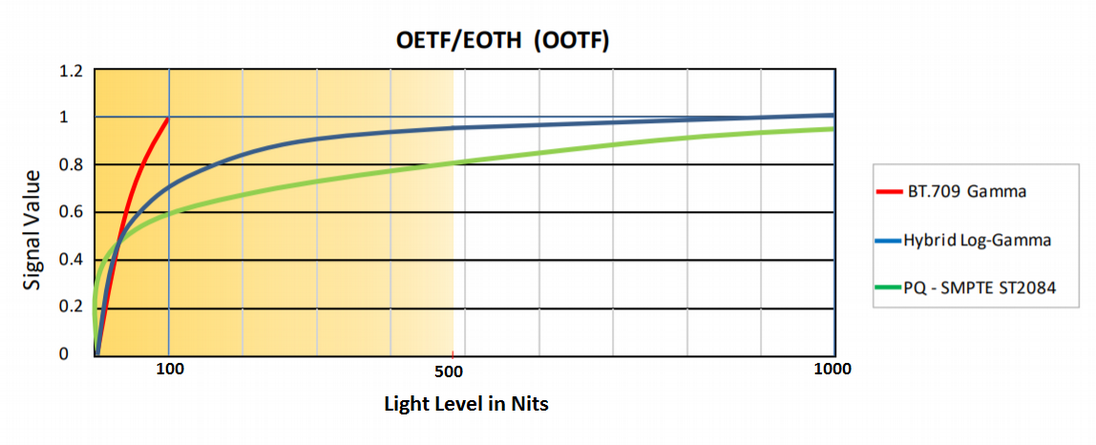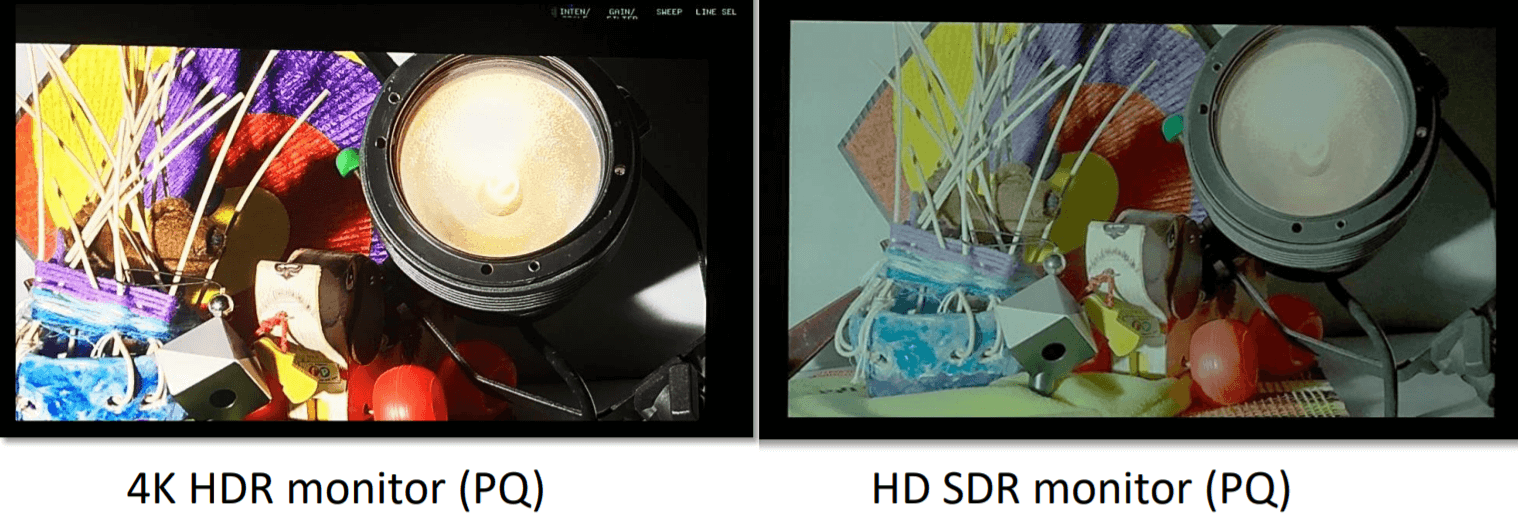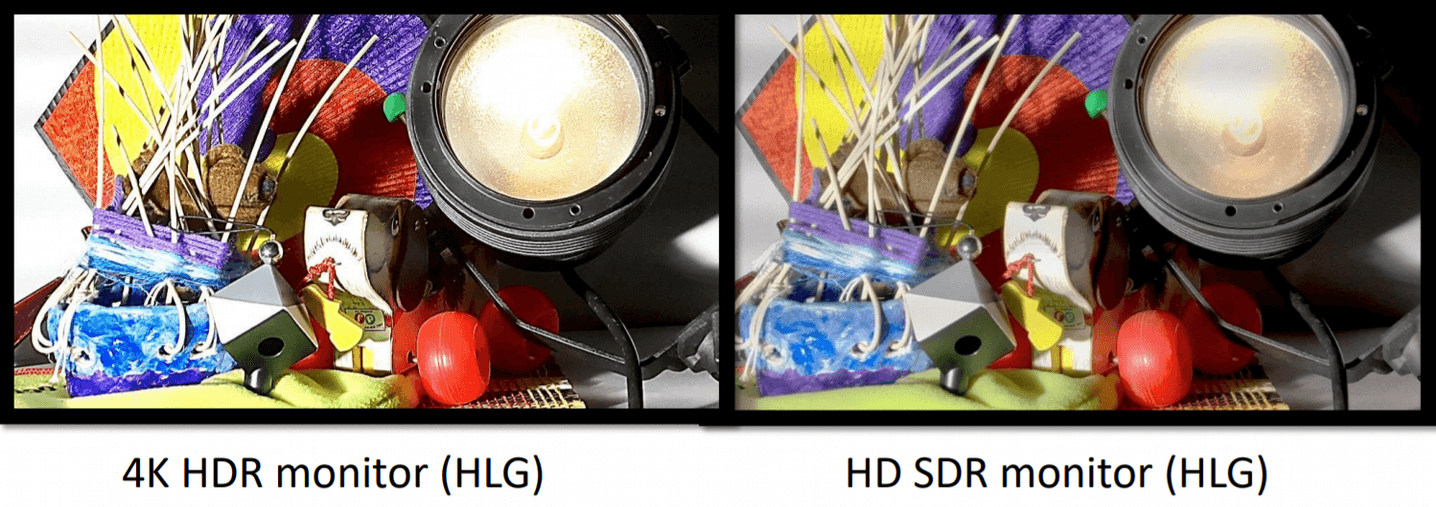
17 Jun HDR Insights Article 2 : PQ and HLG transfer functions for HDR
In the previous article HDR introduction, we discussed the benefits HDR (High Dynamic Range) brings about in terms of quality of the video. This article talks about how that is achieved.
To display the digital images on the screen, display devices need to convert the pixel values to corresponding light values. This process is usually non-linear and is called EOTF (Electro-Optical Transfer Function). Different types of “Transfer Functions” are supported in different display devices.
Regular HDTV display devices (SDR – Standard Dynamic Range – monitors) normally use BT.709 Gamma transfer function to convert the video signal into light. These monitors are primarily designed to display images with brightness range of up to 100 Nits (cd/m2).
High Dynamic Range – Transfer Functions (PQ & HLG)
HDR defines two additional transfer functions to handle this issue – Perceptual Quantizer (PQ) and Hybrid Log-Gamma (HLG). HDR PQ is an absolute, display-referred signal while HDR HLG is a relative, scene-referred signal. This means that HLG enabled display devices automatically adapts the light levels based on the content and their own display capabilities while PQ enabled display devices need to implement tone mapping to adapt the light levels. Display devices use content metadata to display PQ coded images. This can come once for the entire video stream (static) or for each individual shot (dynamic)
It is expected that under ideal conditions, dynamic PQ based transformation will achieve the best quality results at the cost of compatibility with existing display systems. Please see examples below:
HDR – Signal to light mapping
The graph below describes the mapping of light levels for various transfer functions. Vertical axis shows the signal values on a scale of 0-1 with 0 being black and 1 being white. This is done to make the signal range, bit depth agnostic. Horizontal axis shows the light level in Nits of display device.

Human beings are more sensitive to changes in darker region compared to changes in brighter regions. This property is also exploited in HDR systems providing more granularity in darker regions compared to brighter regions. The graph above depicts that light level range in darker region is represented by a larger signal value range compared to the brighter regions – meaning more granular representation in darker regions. While this is more evenly distributed for the BT.709 based displays, it become less granular for HDR displays in the brighter regions. In case of HLG, more than half of signal values are represented for light level between 0-60 Nits and the remaining signal values are represented in 60-1000 Nits range. Similarly, in case of PQ ST2084 based displays, approx. half of the signal values are represented for light level between 0-40 Nits and the remaining half of signal values are represented in 60-1000 Nits range.
According to the graph, HDR HLG is similar to BT.709 in lower brightness regions therefore offering a better compatibility with the existing SDR display devices. However, HDR PQ is quite different from BT.709. If we try to display the PQ HDR image on a SDR display, darker regions represented by PQ will invariably become brighter thereby reducing the contrast levels of the image, the result being a washed out image (see below)

HLG based image looks much better on a SDR monitor:

While PQ based transforms offers promise to display best quality results on HDR enabled monitors, in comparison to HLG, it requires proper tone mapping by display devices.
This topic will be discussed in our next blog article – Tone mapping.
Definitions
cd/m2 – The candela (cd) is the base unit of luminous intensity in the International System of Units (SI); that is, luminous power per unit solid angle emitted by a point light source in a particular direction. A common wax candle emits light with a luminous intensity of roughly one candela.
Nits – A non-SI unit used to describe the luminance. 1 Nit = 1 cd/m2.
HDR – High Dynamic range. It is a technology that improves the brightness & contrast range in an image (up to 10,000 cd/m2)
SDR – Standard Dynamic range. It refers to the brightness/contrast range that is usually available in regular, non-HDR televisions usually with range of up to 100 cd/m2. This term came into existence after HDR was introduced
WCG – Wide Color Gamut. Color gamut that offer a wider range of colors than BT.709. DCI-P3 and BT.2020 are examples of WCG offering more realistic representation of images on display devices.
EOTF – electro-optical transfer function. A mathematical transfer function that describes how digital values will be converted to light on a display device.
OETF – optical-electro transfer function. A mathematical transfer function that describes how the light values will be converted to digital values typically within cameras.
OOTF – opto-optical transfer function. This transfer function compensates for the difference in tonal perception between the environment of the camera and that of the display.
PQ – PQ (or Perceptual Quantizer) is a transfer function devised to represent the wide brightness range (up to 10,000 Nits) in HDR devices.
HLG – HLG (or Hybrid Log Gamma) is a transfer function devised to represent the wide brightness range in HDR devices. HLG is quite compatible with existing SDR devices in the SDR range.



